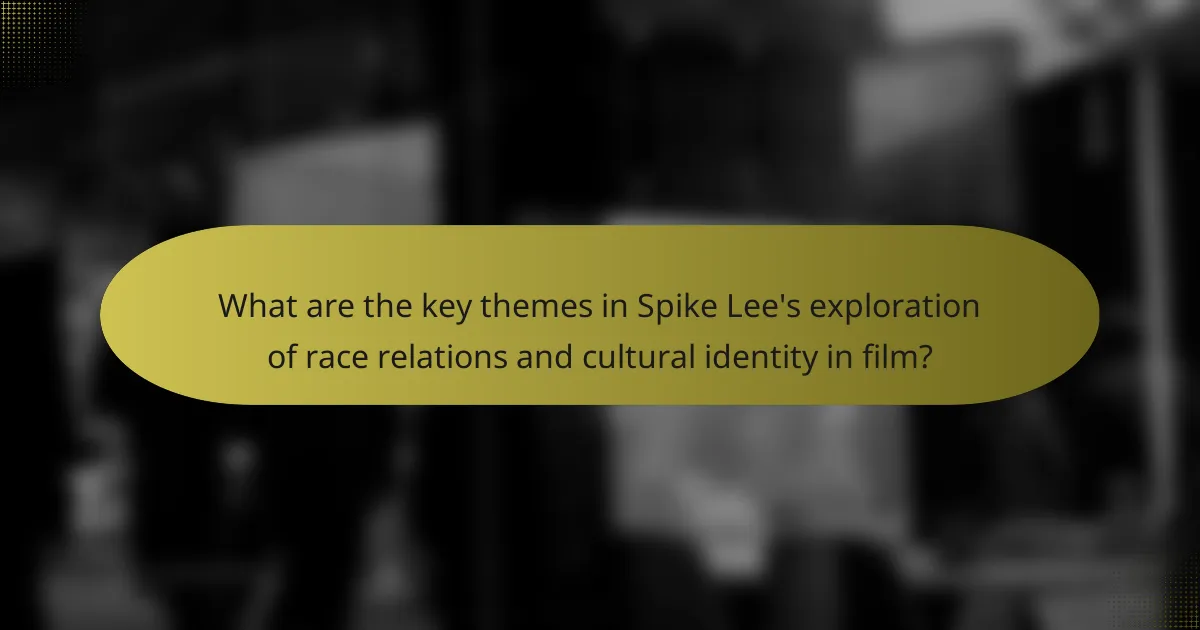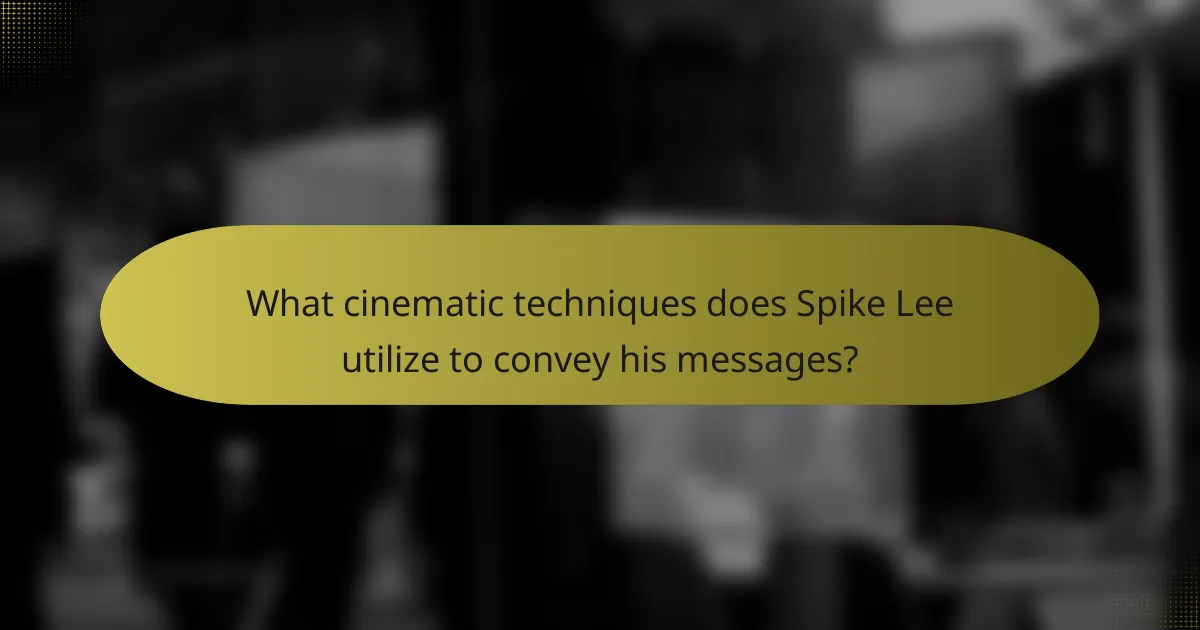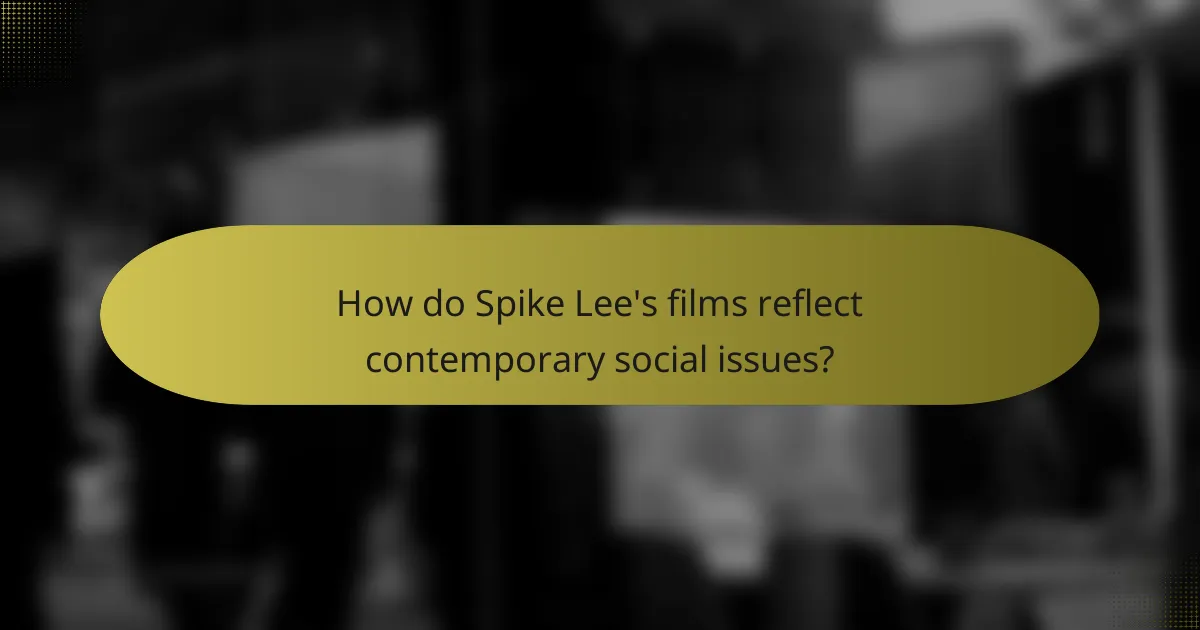Spike Lee is a prominent filmmaker known for his in-depth exploration of race relations and cultural identity through his films. His work addresses systemic racism, identity conflict, and community resilience, often depicting characters who confront discrimination and societal barriers while navigating their cultural heritage. Key films such as “Do the Right Thing” and “Malcolm X” illustrate these themes, showcasing racial tensions and the struggle for self-identity. Lee employs various cinematic techniques, including unique camera angles, vibrant colors, and strategic music choices, to enhance his narratives and engage audiences in critical discussions about contemporary social issues, including inequality and systemic injustice.

What are the key themes in Spike Lee’s exploration of race relations and cultural identity in film?
Spike Lee’s exploration of race relations and cultural identity in film includes themes of systemic racism, identity conflict, and community resilience. Systemic racism is depicted through characters facing discrimination and societal barriers. Identity conflict arises as individuals navigate their cultural heritage and societal expectations. Community resilience is showcased through collective action and solidarity in the face of adversity. These themes are evident in films like “Do the Right Thing,” where racial tensions escalate in a Brooklyn neighborhood, and “Malcolm X,” which portrays the struggle for self-identity and empowerment. Lee’s work invites critical reflection on the complexities of race and identity in America.
How does Spike Lee use storytelling to address race relations?
Spike Lee uses storytelling to address race relations by weaving complex narratives that highlight social issues. His films often depict the struggles and experiences of African Americans. He employs character-driven plots to illustrate systemic racism and personal conflict. For instance, “Do the Right Thing” showcases racial tension in a Brooklyn neighborhood. The film’s climax reveals the consequences of prejudice and violence. Lee incorporates real-life events and historical context to ground his stories. This approach fosters empathy and understanding among viewers. By using dialogue, music, and visual symbolism, he enhances the emotional impact of his narratives. Lee’s storytelling serves as a platform for dialogue about race relations in America.
What narrative techniques does Spike Lee employ in his films?
Spike Lee employs various narrative techniques in his films. He often uses non-linear storytelling to create a dynamic viewing experience. This technique allows for flashbacks and multiple perspectives. Lee integrates real-life events and historical context to enhance authenticity. He frequently employs direct address, allowing characters to speak to the audience. This technique fosters a personal connection with viewers. Additionally, his films often include symbolic imagery to convey deeper themes. Lee’s use of music and sound enhances emotional resonance. He also incorporates satire and humor to critique social issues, particularly around race relations. These techniques collectively highlight cultural identity and provoke thought on societal challenges.
How do character arcs reflect cultural identity in his storytelling?
Character arcs in Spike Lee’s storytelling reflect cultural identity by illustrating the complexities of race and social issues. His characters often undergo significant transformations that mirror the struggles faced by their communities. For example, in “Do the Right Thing,” Mookie’s evolution highlights the tension between personal responsibility and societal expectations. This arc emphasizes the impact of systemic racism on individual choices. Furthermore, Lee’s characters frequently confront cultural stereotypes, challenging viewers to reconsider their perceptions. His storytelling showcases the nuances of African American experiences, making cultural identity a central theme. By integrating personal growth with cultural context, Lee effectively communicates the significance of identity in shaping narratives.
Why is Spike Lee’s perspective on race relations significant?
Spike Lee’s perspective on race relations is significant due to his unique storytelling and cultural insights. He addresses systemic racism and social injustices through his films. His works often highlight the African American experience in a nuanced way. Films like “Do the Right Thing” and “Malcolm X” provoke discussions on race. Lee’s narratives challenge stereotypes and encourage critical thinking. His influence extends beyond cinema into broader cultural conversations. He has received numerous accolades for his contributions to film and social commentary. Lee’s perspective remains relevant in contemporary discussions about race relations.
What historical context influences his work?
Spike Lee’s work is influenced by the historical context of racial tensions in America. The Civil Rights Movement of the 1960s laid a foundation for his exploration of race relations. The aftermath of the movement saw ongoing struggles against systemic racism and inequality. Events such as the 1991 Rodney King beating and subsequent riots highlighted racial divisions. Lee’s films often reflect these societal issues, addressing themes of identity and injustice. The historical backdrop of urban violence and economic disparity also shapes his narratives. Moreover, the cultural renaissance of the 1980s and 1990s provided a platform for African American voices in cinema. This rich historical context informs Lee’s storytelling and artistic vision.
How does Spike Lee’s background shape his portrayal of race?
Spike Lee’s background significantly shapes his portrayal of race in his films. He was born in Atlanta, Georgia, and raised in a middle-class African American family. This upbringing provides him with a unique perspective on racial issues. His experiences in predominantly black neighborhoods influence his storytelling. Lee often highlights systemic racism and social injustices in his work. His education at Morehouse College and NYU’s Tisch School of the Arts further informs his artistic vision. He blends personal narratives with broader societal themes. This approach resonates with audiences and sparks important conversations about race. Lee’s films, such as “Do the Right Thing,” reflect his commitment to exploring complex racial dynamics.

What cinematic techniques does Spike Lee utilize to convey his messages?
Spike Lee utilizes various cinematic techniques to convey his messages. He employs distinctive camera angles, such as the “double dolly shot,” to create a sense of dislocation. This technique allows characters to appear both physically present and emotionally detached. Lee also uses vibrant color palettes to evoke specific emotions and highlight cultural identity. His strategic use of music enhances the narrative, often incorporating hip-hop to connect with contemporary culture. Additionally, Lee frequently includes direct addresses to the camera, engaging the audience and prompting reflection on social issues. His films often feature nonlinear storytelling, which challenges viewers to think critically about the narrative. These techniques collectively serve to amplify Lee’s commentary on race relations and cultural identity.
How does visual style impact the audience’s understanding of race?
Visual style significantly impacts the audience’s understanding of race by shaping perceptions and emotions. This includes elements like color, composition, and cinematography. For instance, Spike Lee often uses vibrant colors to evoke cultural identity. His framing choices can highlight social issues related to race. The use of specific visual motifs can reinforce stereotypes or challenge them. Studies show that visual representation influences audience attitudes towards racial groups. In films like “Do the Right Thing,” visual style is integral to conveying complex racial dynamics. This demonstrates how aesthetics can inform societal views on race.
What role does cinematography play in his films?
Cinematography in Spike Lee’s films plays a crucial role in conveying emotional depth and cultural context. It enhances storytelling by using unique camera angles and vibrant color palettes. Lee often employs techniques like the dolly shot to create a sense of urgency. His use of contrasting lighting highlights themes of racial tension. Specific scenes, such as those in “Do the Right Thing,” demonstrate how cinematography shapes audience perceptions. The visual style complements the narrative, making social commentary more impactful. Lee’s innovative approach to cinematography distinguishes his work within the film industry. It serves as a powerful tool for exploring complex themes of race and identity.
How does color symbolism enhance cultural themes?
Color symbolism enhances cultural themes by conveying deeper meanings associated with specific colors. In Spike Lee’s films, colors often represent emotions, social issues, or cultural identities. For example, the color red may symbolize passion or violence, while blue can represent calmness or sadness. These color choices help to underscore the narratives and themes present in his storytelling. Research indicates that color can evoke psychological responses, influencing audience perception. In “Do the Right Thing,” the vibrant colors reflect the intensity of racial tensions, enhancing the film’s message. Thus, color symbolism serves as a powerful tool in expressing and amplifying cultural themes in Lee’s work.
In what ways does Spike Lee incorporate music into his films?
Spike Lee incorporates music into his films through strategic use of soundtracks, original scores, and cultural references. He often selects music that resonates with the themes of race and identity. For example, he frequently uses hip-hop and jazz to reflect African American culture. His collaboration with composer Terence Blanchard has resulted in memorable scores that enhance emotional depth. Lee also integrates popular songs to evoke nostalgia and connect with audiences. Notably, his film “Do the Right Thing” features a diverse soundtrack that underscores the film’s social commentary. By blending music with narrative, Lee elevates the storytelling experience in his films.
What genres of music are prevalent in his soundtracks?
Spike Lee’s soundtracks predominantly feature jazz, hip-hop, and R&B genres. Jazz elements reflect the cultural heritage and emotional depth in his films. Hip-hop showcases contemporary urban culture and social issues. R&B adds layers of emotion and personal storytelling. His collaborations with artists like Terence Blanchard highlight jazz’s importance. The use of hip-hop tracks often aligns with the narratives of his films. R&B songs frequently underscore pivotal emotional moments. These genres collectively enhance the thematic exploration of race relations and cultural identity in his work.
How does music influence the emotional tone of his narratives?
Music significantly influences the emotional tone of Spike Lee’s narratives. It enhances the storytelling by evoking specific feelings and setting the atmosphere. For instance, Lee often uses jazz, hip-hop, and gospel music to reflect cultural identity. These genres resonate with the themes of race and community present in his films. The soundtrack choices amplify emotional moments, creating a deeper connection with the audience. In “Do the Right Thing,” the music underscores the tension and urgency of racial conflict. Studies show that music can alter emotional perception in film, reinforcing Lee’s narrative intentions. Overall, music is a crucial tool for conveying the emotional landscape in Spike Lee’s work.

How do Spike Lee’s films reflect contemporary social issues?
Spike Lee’s films reflect contemporary social issues by addressing themes of race, inequality, and systemic injustice. His works often showcase the struggles of African Americans in urban settings. For example, “Do the Right Thing” highlights racial tensions in a Brooklyn neighborhood. The film’s portrayal of police brutality resonates with ongoing discussions about racial profiling. Additionally, “BlacKkKlansman” confronts the resurgence of white supremacy in modern America. This film connects historical racism to today’s societal challenges. Lee’s storytelling emphasizes the importance of dialogue about race and community. His films serve as a mirror to current social dynamics, prompting viewers to engage with pressing issues.
What current events does Spike Lee address in his recent works?
Spike Lee addresses various current events in his recent works, particularly focusing on racial injustice and police brutality. His film “Da 5 Bloods” highlights the experiences of Black soldiers during the Vietnam War and critiques systemic racism. Additionally, his documentary “American Utopia” reflects on social issues, including gun violence and the Black Lives Matter movement. Lee’s works emphasize the ongoing struggles for racial equality and the importance of cultural identity. He often incorporates real-life events, such as protests and social movements, to underscore the urgency of these issues.
How does he comment on police brutality and systemic racism?
Spike Lee addresses police brutality and systemic racism through his films and public statements. He often portrays the harsh realities faced by marginalized communities. In “Do the Right Thing,” he illustrates racial tensions and police violence in urban settings. This film sparked conversations about race relations in America. Lee also uses his platform to advocate for social justice. He emphasizes the need for systemic change in law enforcement. His documentary “4 Little Girls” highlights the impact of racial violence. Through these works, he critiques societal norms and encourages dialogue on these critical issues.
What role do protests and activism play in his narratives?
Protests and activism are central themes in Spike Lee’s narratives. They serve as critical reflections of societal issues and injustices. Lee often uses these elements to highlight racial tensions and the struggle for civil rights. His films depict real-life events, such as the protests surrounding police brutality. For example, “Do the Right Thing” portrays the explosive aftermath of racial conflict in a Brooklyn neighborhood. This film illustrates how activism can arise from everyday injustices. Lee’s work emphasizes the importance of community response to systemic oppression. Through his narratives, he advocates for awareness and change, making activism an integral part of his storytelling.
What lessons can filmmakers learn from Spike Lee’s approach to race and identity?
Filmmakers can learn the importance of authentic representation from Spike Lee’s approach to race and identity. His films often showcase the complexities of African American experiences. Lee emphasizes the need for nuanced storytelling that reflects real-life struggles. He uses personal narratives to connect audiences with broader social issues. For instance, “Do the Right Thing” addresses racial tensions in a relatable way. This film highlights the impact of environment on identity. Lee’s work encourages filmmakers to challenge stereotypes and promote dialogue. By doing so, they can foster understanding and empathy among diverse audiences.
How can emerging filmmakers effectively address social issues through film?
Emerging filmmakers can effectively address social issues through film by highlighting relevant narratives and fostering dialogue. They should focus on authentic storytelling to resonate with audiences. This approach encourages empathy and understanding of complex social issues. Using diverse perspectives enriches the narrative and broadens the impact. Collaborating with communities affected by these issues enhances authenticity. Additionally, utilizing social media platforms amplifies the reach of their messages. Historical examples, such as Spike Lee’s films, demonstrate the power of cinema in discussing race relations and cultural identity. Lee’s work has sparked conversations and raised awareness about social injustices. These strategies can empower emerging filmmakers to make meaningful contributions to societal discourse.
What best practices can be derived from Spike Lee’s storytelling techniques?
Spike Lee’s storytelling techniques emphasize authenticity and cultural representation. He integrates personal narratives to connect with audiences deeply. His use of non-linear storytelling enhances emotional engagement. Lee often incorporates historical context to provide depth to his characters. He utilizes strong visual imagery to convey themes effectively. Dialogue in his films reflects real-life conversations, adding realism. Lee’s focus on social issues encourages critical discussions among viewers. His innovative use of music complements the narrative, enhancing emotional resonance.
Spike Lee’s exploration of race relations and cultural identity in film serves as the primary focus of this article. It examines key themes such as systemic racism, identity conflict, and community resilience, as depicted in films like “Do the Right Thing” and “Malcolm X.” The article also discusses Lee’s narrative techniques, including non-linear storytelling, character arcs, and the use of music and cinematography to enhance emotional impact and provoke dialogue on social issues. Additionally, it highlights the historical context influencing his work and the significance of his perspective on contemporary race relations. Overall, the article provides a comprehensive analysis of Lee’s contributions to understanding race and identity through cinema.